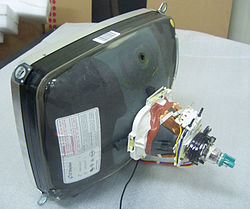 |
| [picture - cathode ray tube of the early televisions] |
Back in the day when smartphones didn't existed and television and computers monitors were new to the market, they had these Cathode Ray Tubes (CRT) in them. A CRT is a specialised vacuum tube in which images are produced when an electron beam strikes a phosphorescent surface [phosphorescent surface is a surface which emits light after exposed to radiation].
With time the technology grew and in 1997 LED came to the market to replace those old CRT displays.
LED
| [picture - pixel arrangement in an LED/LCD] |
LEDs are light emitting diodes which are tiny, energy-efficient, coloured indicator lights usually seen in electronic panels. LED was different than the earlier lamps. The earlier lamps emitted light through a phenomenon called incandescence in which the heating of a wire filament, when charged with electric current causes the wire to emit photons, i.e., light. LEDs works on a different phenomenon called electroluminescence in which the emission of light is caused by electric excitation of a material [electric excitation is the transfer of a bound electron to a more energetic, but still bound state]. Each LED is a junction diode which makes light. Everytime the electrons cross the junction, they nip into holes on the other side, release surplus energy and gives off a quick flash of light.
OLED
[picture - pixel arrangement of an OLED] |
OLEDs works almost similarly like the LED, but instead they use organic molecules to produce their electrons and holes. The basis structure of an OLED is an emissive layer sandwiched between a cathode and an anode. A modern OLED requires more layers to make it more efficient and durable. OLEDs can produce coloured light by adding coloured filters into these sandwiched layers. These coloured OLEDs are of three basic colours - red, green and blue, are put next to each other in thousands of numbers which are independently operated to make them work like a pixel. This results in a more complex, hi-resolution coloured pictures.
OLED vs LED/LCD[picture - on the left - LED/LCD, on the right OLED]
Well, now we have some idea that how these displays work, so it's time to figure out which one is better.- Black Levels - For an excellent picture quality the displays should be able to produce more deeper and dark blacks as it allows higher contrast and rich colours which results in more realistic and brilliant images. When it comes to black levels OLED outperforms LED/LCD.
- Brightness - LEDs has better brightness as it can go extreme bright with it's backlight and with the quantum dots it can bright even further. OLED can too get extreme bright but not as much as LED/LCD. OLED can damage itself if used at extreme brightness for longer periods.
- Contrast Ratio - OLED has the best contrast ratio of any modern display as it can get bright and can also produce deep blacks which is not possible in LED/LCD. The contrast of OLED helps it to get more realistic picture quality.
- Refresh Ratio - Both the displays are pretty same here. OLEDs have a 120Hz of refresh rates. LED/LCD has more options as the cheaper displays can have upto 60Hz but some higher end displays have 240Hz.
- Viewing Angles - With LED displays the best viewing angle is the center of the screen because the quality of the picture decreases when moved further to either side. The OLED has far more better viewing angles. An OLED display has upto 84 degrees of viewing angles as compared to the LED/LCD with only 54 degrees.
- Resolution - In this case both the displays are available in Ultra HD 4K forms.
- Energy Consumption - LED/LCD are more power efficient as compared to OLED. The brightness of the LED/LCD can be turned to low which draws less power but this can't be done with the OLED as it will reduce the contrast which will not be ideal for the picture quality.
- Screen Size - LCD TVs are available in more sizes as compared to OLED. OLED is available in four sizes - 55 inches, 65 inches, 77 inches and 90 inches but LED/LCD are available in sizes from 20 inches to 100 inches. In case of mobile phones again LED/LCD are available in more sizes as compared to OLED.
- Price - OLED are more expensive as compared to LED/LCD as OLED goes through a very complex production process and OLED is also newer as compared to the LED/LCD displays.

:no_upscale()/cdn.vox-cdn.com/uploads/chorus_asset/file/9991893/DSCF2669.jpg)
Comments
Post a Comment